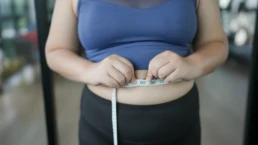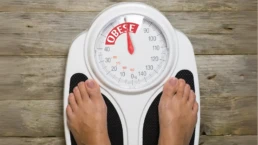Medically reviewed by Dr Chandril Chugh,
Renowned Neurologist and American Trained Specialist
High blood pressure is a common health condition that affects many individuals worldwide. If left unmanaged, it can increase the risk of heart disease and other complications. While medication may be necessary for some individuals, there are several lifestyle changes that can help lower blood pressure naturally.
Table of Contents
ToggleBy making simple yet effective adjustments to your daily routine, you can take control of your blood pressure and improve your overall health. In this article, we will explore various strategies and lifestyle changes that can help reduce blood pressure levels and promote a healthier cardiovascular system.
Key Takeaways:
- Implementing lifestyle changes can help lower blood pressure naturally.
- Weight loss and waistline management are essential in reducing blood pressure.
- Regular exercise, both aerobic and strength training, can significantly impact blood pressure levels.
- A healthy diet, such as the DASH and Mediterranean diets, can lower high blood pressure.
- Reducing sodium intake, limiting alcohol consumption, quitting smoking, improving sleep quality, and managing stress are all beneficial for blood pressure management.
Lose Extra Pounds and Watch Your Waistline
Carrying excess weight can contribute to high blood pressure. Obesity is a risk factor for various health conditions, including hypertension. However, even a modest weight loss can have a significant impact on reducing blood pressure.
In general, for every kilogram of weight lost, blood pressure may decrease by about 1 millimeter of mercury (mm Hg). This means that losing just a few pounds can make a noticeable difference in your blood pressure readings.
In addition to overall weight loss, it is also essential to keep an eye on your waistline. Excessive waist measurements can increase the risk of high blood pressure, as abdominal fat is particularly harmful to your health. Men should aim for a waist measurement of less than 40 inches, while women should aim for a measurement of less than 35 inches.
To achieve weight loss and maintain a healthy waistline, a combination of regular physical activity and a balanced diet is key. Aim for a calorie deficit by consuming nutrient-rich foods and engaging in regular exercise. Consult with a healthcare professional or a registered dietitian to develop a personalized weight loss plan that suits your needs and preferences.
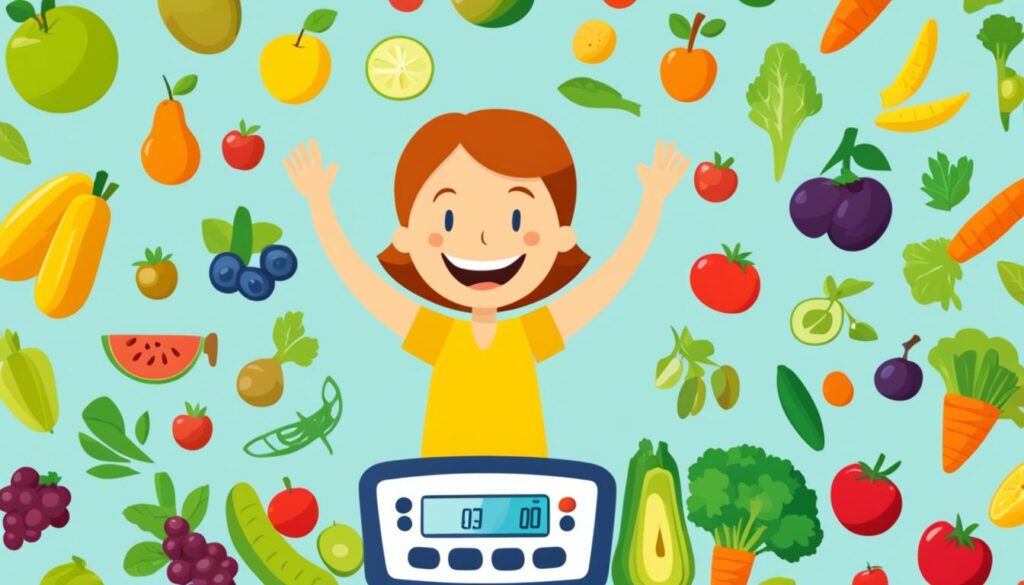
| Waist Measurement Guidelines | Men | Women |
|---|---|---|
| Increased Risk of High Blood Pressure | 40 inches or more | 35 inches or more |
| Healthy Waistline | Less than 40 inches | Less than 35 inches |
Exercise Regularly
Regular physical activity is essential for maintaining healthy blood pressure levels. Engaging in at least 30 minutes of moderate physical activity, such as walking or cycling, can lower blood pressure by about 5 to 8 mm Hg. Additionally, incorporating aerobic exercises and strength training into your exercise routine can provide additional benefits.
Aerobic exercises, such as running, swimming, or dancing, help to strengthen your heart and improve cardiovascular fitness. They increase your heart rate, causing you to breathe harder and sweat, which contributes to lowering your blood pressure. Aim for about 150 minutes of moderate-intensity aerobic activity per week.
Strength training exercises, on the other hand, focus on building and toning your muscles. These exercises, which typically involve lifting weights or using resistance bands, not only increase your muscle strength but also have a positive effect on blood pressure. By incorporating resistance training into your routine at least two days a week, you can further lower your blood pressure.
Consult with a healthcare provider for personalized guidance
Before starting any exercise program, it is important to consult with a healthcare provider, especially if you have pre-existing health conditions or are new to physical activity. They can assess your health status and provide recommendations tailored to your individual needs and abilities. Consulting with a healthcare provider will ensure that you engage in activities that are safe and suitable for your current physical condition.
Sample Table: Aerobic Exercise vs. Strength Training
| Aerobic Exercise | Strength Training |
|---|---|
| Increases cardiovascular fitness | Builds and tones muscles |
| Helps lower blood pressure | Has a positive effect on blood pressure |
| Improves lung function | Increases bone density |
| Burns calories and aids in weight management | Boosts metabolism and supports weight loss |
By including both aerobic exercises and strength training in your regular physical activity routine, you can reap the maximum benefits for your blood pressure and overall health. Speak to your healthcare provider to develop an exercise program that suits your specific needs and goals.
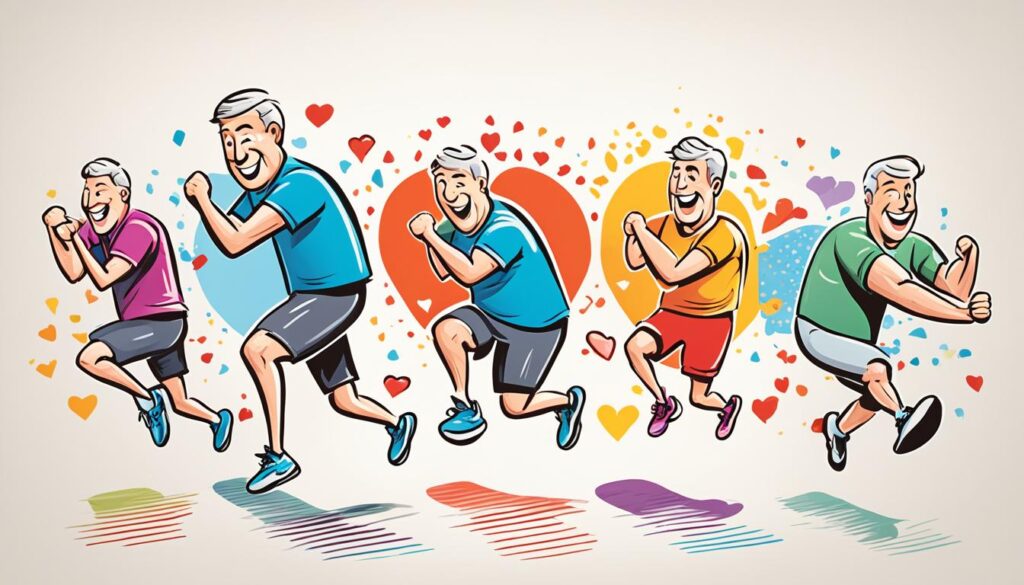
Eat a Healthy Diet
A nutritious diet plays a crucial role in managing blood pressure. Two popular and effective diets for lowering high blood pressure are the Dietary Approaches to Stop Hypertension (DASH) diet and the Mediterranean diet. These diets prioritize whole grains, fruits, vegetables, and low-fat dairy products while limiting saturated fat and cholesterol.
By following the DASH diet or the Mediterranean diet, you can significantly improve your blood pressure levels and overall health. Let’s take a closer look at the key principles of these diets:
The DASH Diet
- Emphasizes whole grains, fruits, vegetables, and low-fat dairy products
- Includes lean meats, poultry, and fish in moderation
- Limits saturated fat, cholesterol, and added sugars
- Encourages the consumption of nuts, seeds, and legumes
The Mediterranean Diet
- Highlights fruits, vegetables, whole grains, and legumes
- Emphasizes healthy fats like olive oil and nuts
- Includes moderate amounts of fish, poultry, and dairy
- Restricts red meat and sweets
- Integrates regular physical activity and enjoyment of meals with family and friends
Both diets have been shown to effectively lower blood pressure due to their focus on nutrient-rich foods and their ability to reduce sodium intake. Speaking of which, let’s discuss the importance of potassium in managing blood pressure.
Potassium and Sodium: Balancing Act for Blood Pressure
Eating foods rich in potassium can help counteract the effects of sodium on blood pressure. Potassium plays a vital role in regulating fluid balance and helping blood vessels dilate, which can lower blood pressure. Fruits and vegetables, such as bananas, oranges, spinach, and tomatoes, are excellent sources of potassium.
To optimize your potassium intake, aim for a daily consumption of 3,500 to 5,000 mg of potassium. By doing so, you may be able to lower your blood pressure by approximately 4 to 5 mm Hg.
Keep in mind that it’s essential to strike a balance between potassium and sodium intake. While potassium helps lower blood pressure, consuming excessive sodium can have the opposite effect. Let’s explore how to reduce sodium in your diet in the next section.
Reduce Salt (Sodium) in Your Diet
Excessive sodium intake is closely linked to high blood pressure. To improve your heart health, it’s important to limit your sodium intake to 2,300 mg per day or less. Here are some effective strategies to help you achieve this:
- Read Food Labels: Take the time to read and understand food labels. Look for products that are low in sodium or labeled as “sodium-free” or “low-sodium”. This will help you make informed choices and select foods with lower sodium content.
- Choose Low-Sodium Options: Opt for low-sodium alternatives when available. For example, choose low-sodium canned vegetables over regular ones, or select fresh produce instead of processed options that often contain added sodium.
- Reduce Processed Foods: Processed and packaged foods tend to be high in sodium. Limiting your consumption of these foods can significantly reduce your sodium intake. Instead, focus on incorporating fresh, whole foods into your diet.
- Cook at Home: Cooking meals at home gives you better control over the ingredients and allows you to limit the amount of salt you add. Experiment with herbs, spices, and flavorful ingredients to enhance the taste of your dishes without relying on excessive sodium.
The Importance of Sodium Intake
Reducing sodium intake is crucial for managing blood pressure and improving heart health. By making conscious choices and being mindful of your sodium consumption, you can take a significant step towards lowering your blood pressure naturally.

Limit Alcohol
Drinking alcohol in moderation can be part of a healthy lifestyle, but excessive alcohol consumption can raise blood pressure. It’s important to find a balance that promotes overall well-being.
For women, it is generally recommended to limit alcohol intake to no more than one drink per day. Men, on the other hand, should aim for no more than two drinks per day. By adhering to these guidelines, you can enjoy the social aspects of alcohol while minimizing the potential negative effects on your blood pressure.
It’s worth noting that excessive alcohol consumption can interfere with the effectiveness of blood pressure medications and may increase blood pressure levels. Therefore, it is essential to monitor your alcohol consumption and make informed decisions about moderate drinking.
| Alcohol Consumption | Recommended Limits |
|---|---|
| Women | No more than one drink per day |
| Men | No more than two drinks per day |
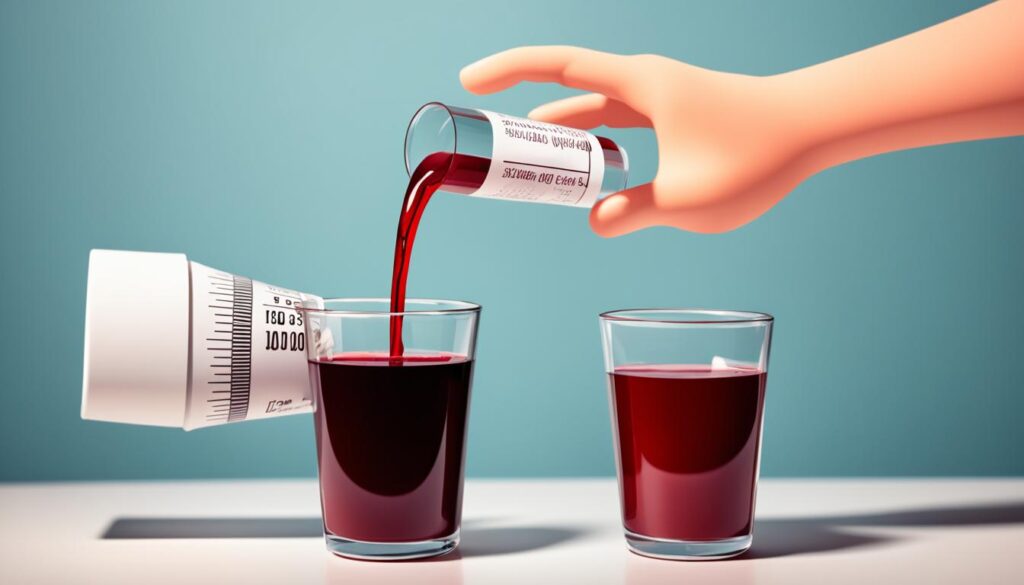
Remember, alcohol affects individuals differently, and certain factors such as age, health conditions, and medications can influence alcohol’s impact. If you have concerns about alcohol consumption and its effects on your blood pressure, it is best to consult with your healthcare provider for personalized advice and guidance.
Quit Smoking
Smoking is a significant risk factor for heart disease and can have harmful effects on blood pressure. When you smoke, the chemicals in tobacco can cause your blood vessels to narrow and constrict, leading to an increase in blood pressure. Quitting smoking is not only crucial for your overall health but also for lowering your blood pressure and reducing the risk of heart disease.
The Harmful Effects of Smoking
Smoking has detrimental effects on your cardiovascular system. It can damage your blood vessels, making them less flexible and more prone to blockages. This increases the risk of developing high blood pressure and can eventually lead to heart attacks, strokes, and other heart-related complications.
In addition to affecting your blood pressure and cardiovascular health, smoking also damages your lungs, leading to respiratory problems such as chronic bronchitis, emphysema, and lung cancer. It can also increase the risk of other types of cancer, including those of the mouth, throat, esophagus, bladder, and kidney.
For individuals who already have high blood pressure, smoking exacerbates the condition and makes it more challenging to manage. By quitting smoking, you can significantly improve your blood pressure levels and reduce the risk of further complications.
Seeking Support and Resources
Quitting smoking can be challenging, but with the right support and resources, you can increase your chances of success. There are various methods and strategies available to help you quit smoking, such as nicotine replacement therapies, medications, counseling, and support groups.
It’s essential to reach out to healthcare professionals, such as your doctor or a smoking cessation specialist, who can provide guidance tailored to your specific needs. They can help you create a personalized quit plan, offer advice on coping with cravings and withdrawal symptoms, and recommend effective strategies to stay smoke-free.
Remember, quitting smoking not only lowers your blood pressure but also improves your overall health and well-being. Take the first step towards a healthier life by seeking the support you need to quit smoking for good.
Get a Good Night’s Sleep
Poor sleep quality and inadequate sleep duration can contribute to high blood pressure. Addressing sleep issues is crucial for improving blood pressure levels and promoting overall health. Here are some tips for achieving better sleep quality and lowering blood pressure:
Create a Regular Sleep Schedule
Establishing a consistent sleep schedule helps regulate your body’s internal clock, promoting better sleep quality. Try to go to bed and wake up at the same time every day, even on weekends.
Create a Restful Sleep Environment
Make your bedroom a peaceful and comfortable space that promotes relaxation. Eliminate distractions like electronic devices and ensure your room is cool, dark, and quiet. Consider using blackout curtains, earplugs, or a white noise machine if necessary.
Avoid Stimulating Activities Before Bed
Avoid engaging in stimulating activities close to bedtime, as they can interfere with your ability to fall asleep. Limit your exposure to screens, such as smartphones and computers, and opt for calming activities like reading a book or taking a warm bath.
Manage Stress
Stress can significantly impact sleep quality and blood pressure. Practice stress management techniques such as deep breathing exercises, meditation, or gentle stretching before bed to help relax your mind and body.
By implementing these tips, you can improve your sleep quality, lower your blood pressure, and enhance your overall well-being. Remember, consistently prioritizing a good night’s sleep is essential for maintaining optimal health.
Reduce Stress
Chronic stress can have a detrimental impact on blood pressure. Implementing stress reduction techniques can help lower blood pressure levels. This can include prioritizing and managing tasks, finding ways to relax and unwind, seeking support from loved ones, and practicing gratitude and mindfulness.
Stress Reduction Techniques
- Practice deep breathing exercises to promote relaxation and reduce stress.
- Engage in regular physical activity such as yoga or tai chi to release tension and improve mood.
- Set boundaries and learn to say no to excessive demands or commitments.
- Practice time management techniques to prioritize tasks and reduce feelings of overwhelm.
- Find healthy outlets for stress such as engaging in hobbies, spending time in nature, or listening to calming music.
- Seek social support from friends, family, or support groups to share your feelings and receive guidance.
- Practice gratitude and mindfulness through activities like journaling, meditation, or mindful eating.
By incorporating these stress reduction techniques into your daily routine, you can effectively manage stress and improve your blood pressure levels. Remember, taking care of your mental and emotional well-being is just as important as physical health.
| Technique | Benefits |
|---|---|
| Deep breathing exercises | Reduces anxiety, promotes relaxation |
| Regular physical activity | Reduces stress levels, improves mood |
| Setting boundaries and saying no | Prevents overwhelm, reduces stress |
| Time management techniques | Reduces stress and increases productivity |
| Engaging in hobbies | Provides a healthy outlet for stress |
| Seeking social support | Offers emotional guidance and understanding |
| Practicing gratitude and mindfulness | Enhances positive mindset and reduces stress |
Conclusion
Lowering your blood pressure naturally through lifestyle changes is key to improving your heart health. By adopting a healthy diet, engaging in regular physical activity, managing stress, and making positive lifestyle choices, you can significantly reduce your blood pressure and lower your risk of heart disease.
A nutritious diet, such as the DASH or Mediterranean diet, can help lower blood pressure by emphasizing whole grains, fruits, vegetables, and low-fat dairy products while limiting saturated fat and cholesterol. Additionally, regular physical activity, including aerobic exercise and strength training, can effectively reduce blood pressure.
Managing stress and getting enough sleep are also essential for maintaining healthy blood pressure levels. Implementing stress reduction techniques and establishing a regular sleep schedule can both contribute to improved heart health. It’s important to consult with a healthcare provider for personalized advice and guidance on managing your blood pressure.
By taking these natural steps to lower your blood pressure, you can improve your heart health and reduce the risk of complications. Remember, small lifestyle changes can make a big difference in your overall well-being.
FAQ
Can losing weight help lower blood pressure?
Yes, carrying excess weight can contribute to high blood pressure. Losing even a small amount of weight can have a significant impact on reducing blood pressure.
How much weight loss is needed to decrease blood pressure?
In general, for every kilogram of weight lost, blood pressure may decrease by about 1 millimeter of mercury (mm Hg).
What is the recommended waist measurement to reduce the risk of high blood pressure?
Men should aim for a waist measurement of less than 40 inches, while women should aim for a measurement of less than 35 inches.
How much exercise is recommended to lower blood pressure?
Engaging in at least 30 minutes of moderate physical activity, such as walking or cycling, can lower blood pressure by about 5 to 8 mm Hg.
What types of exercises are beneficial for lowering blood pressure?
High-intensity interval training and strength training exercises can also be beneficial. It’s important to consult with a healthcare provider to develop an exercise program that suits your individual needs and abilities.
Are there any specific diets that can help lower blood pressure?
Yes, the Dietary Approaches to Stop Hypertension (DASH) diet and the Mediterranean diet are both effective in lowering high blood pressure.
What foods should I include in my diet to help lower blood pressure?
Emphasize whole grains, fruits, vegetables, and low-fat dairy products, while limiting saturated fat and cholesterol. Consuming foods rich in potassium, such as fruits and vegetables, can counteract the effects of sodium on blood pressure.
How much potassium should I aim for in my daily diet?
Aim for a daily intake of 3,500 to 5,000 mg of potassium to help lower blood pressure by 4 to 5 mm Hg.
How can I reduce my sodium intake?
Limiting your sodium intake to 2,300 mg per day or less is recommended. This can be achieved by reading food labels, choosing low-sodium options, and reducing the consumption of processed foods.
Can alcohol consumption affect blood pressure?
Yes, excessive alcohol consumption can raise blood pressure. It is generally recommended to limit your alcohol intake to no more than one drink per day for women and two drinks per day for men.
How does smoking impact blood pressure?
Smoking is a significant risk factor for heart disease and can increase blood pressure. Quitting smoking not only helps lower blood pressure but also reduces the risk of heart disease and improves overall health.
How can I improve my sleep quality to lower blood pressure?
Addressing sleep issues can help improve blood pressure levels. Establishing a regular sleep schedule, creating a restful sleep environment, avoiding stimulating activities before bed, and managing stress can all contribute to better sleep quality and lower blood pressure.
How does chronic stress affect blood pressure?
Chronic stress can have a detrimental impact on blood pressure. Implementing stress reduction techniques, such as prioritizing and managing tasks, finding ways to relax and unwind, seeking support from loved ones, and practicing gratitude and mindfulness, can help lower blood pressure levels.
Are lifestyle changes effective in lowering blood pressure?
Yes, lowering blood pressure naturally through lifestyle changes is an effective and safe way to improve heart health. By adopting a healthy diet, engaging in regular physical activity, managing stress, and making other positive lifestyle choices, you can significantly reduce your blood pressure and lower your risk of heart disease.
Should I consult with a healthcare provider for personalized advice on managing my blood pressure?
Yes, it’s essential to consult with a healthcare provider for personalized advice and guidance on managing your blood pressure.
Source Links

This article is medically reviewed by Dr. Chandril Chugh, Board-Certified Neurologist, providing expert insights and reliable health information.
Dr. Chandril Chugh is a U.S.-trained neurologist with over a decade of experience. Known for his compassionate care, he specializes in treating neurological conditions such as migraines, epilepsy, and Parkinson’s disease. Dr. Chugh is highly regarded for his patient-centered approach and dedication to providing personalized care.

